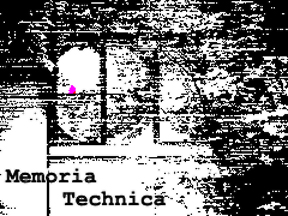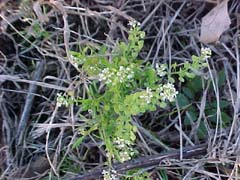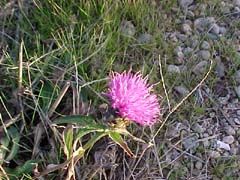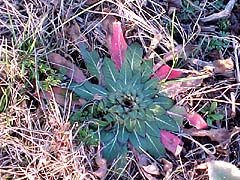|
|
chickweed and thistle December 16, 2001 |
|||||||
|
|
||||||||
|
Today's Bird
Sightings This Life's Bird
Sightings Today's Reading This Year's Reading Photos: Chickweed Thistle Astoundingly common plant whose name I forget |
|
|
It is definitely December though.
Besides being cold enough for me to be wearing my Tuba
Christmas hat (and Nancy her Tuba Christmas scarf) while out
for a walk, the surest sign of December is the presence of
lots of different kinds of ducks. In addition to the
buffleheads, wigeons, hoodies, mallards, and black ducks I
counted I think I also saw a female common Likewise there may well have been several more great cormorants but with the sun low and in my eyes the rest of those cormorant shaped things on pilings in the harbor could have been pieces of wood for all I could tell. You know, ancient decaying pilings can look a lot like cormorants in the right (or maybe I should say wrong) light.
Not that I'm reading gull books lately. Besides The Birds of Heaven: Travels with Cranes, which I bought last week, I'm reading The Shorter Anthology of Traditional Chinese Literature, which I stumbled on this afternoon in the Brown Bookstore and had to have despite my swearing off buying books until I've read the pile I've been acquiring lately. Yüan Mei's "Thoughts upon Student Huang's Borrowing of Books" seems to apply rather well here. "Books fill the homes of the rich and the honored to the very rafters, but how many of the rich and the honored actually read them?" Actually the whole essay seems aimed at me, what with Mei's confessing to spending his entire salary on books until they were piled up everywhere in great profusion and covered with cobwebs and silverfish. Hmm, I'd better go dust my books and check them for silverfish. |
|||||
|
|
|
Copyright © 2001, Janet I. Egan |
|||||

 Along
the East Bay Bike Path, an amazing number of plants are
still blooming. Granted they are weeds, but still... In just
a short walk from Watchemoket Cove down to the unnamed small
cove to the south that Nancy calls "exquisite cove" I
noticed yarrow, Queen Anne's lace, chickweed, thistle, and
red clover all still in bloom in small patches. The late
afternoon sun lit up the thistle flowers like little pink
beacons marking the edges of the path. There was a
surprising amount of green still around for December.
Along
the East Bay Bike Path, an amazing number of plants are
still blooming. Granted they are weeds, but still... In just
a short walk from Watchemoket Cove down to the unnamed small
cove to the south that Nancy calls "exquisite cove" I
noticed yarrow, Queen Anne's lace, chickweed, thistle, and
red clover all still in bloom in small patches. The late
afternoon sun lit up the thistle flowers like little pink
beacons marking the edges of the path. There was a
surprising amount of green still around for December.
 goldeneye.
By that time we were losing the light and the duck kept
diving every time I got the binoculars on it, so I couldn't
be sure. And there were probably a lot more cedar waxwings
than the one I counted. It's odd to see one alone and there
was a great deal of rustling in the bushes where I spotted
the one I did see so I suspect they were chowing down on
various berries out of sight.
goldeneye.
By that time we were losing the light and the duck kept
diving every time I got the binoculars on it, so I couldn't
be sure. And there were probably a lot more cedar waxwings
than the one I counted. It's odd to see one alone and there
was a great deal of rustling in the bushes where I spotted
the one I did see so I suspect they were chowing down on
various berries out of sight.  Once
again I didn't count the gulls and I didn't see the black
headed gull that usually frequents the cove in winter. The
gulls were way too active for me to get good looks at bills
and legs. They just swarmed like insects all over the place.
Some people showed up with bread for the ducks and suddenly
hordes of gulls came from the other side of the harbor,
across the bike path, and across the cove to Veteran's
Memorial Parkway to steal bread from the ducks. How do they
know it's there? Do they see the cars with their sharp avian
vision and just all head over at once? How do they
communicate to their brethren across the harbor? Nothing in
any of my gull books explains this.
Once
again I didn't count the gulls and I didn't see the black
headed gull that usually frequents the cove in winter. The
gulls were way too active for me to get good looks at bills
and legs. They just swarmed like insects all over the place.
Some people showed up with bread for the ducks and suddenly
hordes of gulls came from the other side of the harbor,
across the bike path, and across the cove to Veteran's
Memorial Parkway to steal bread from the ducks. How do they
know it's there? Do they see the cars with their sharp avian
vision and just all head over at once? How do they
communicate to their brethren across the harbor? Nothing in
any of my gull books explains this.